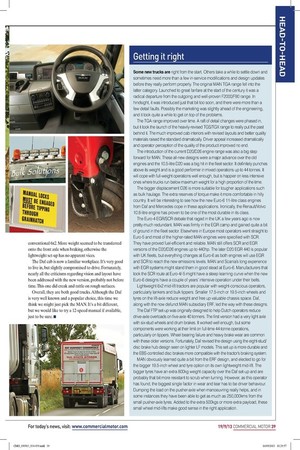Getting it right
Page 30

If you've noticed an error in this article please click here to report it so we can fix it.
Some new trucks are right from the start. Others take a while to settle down and sometimes need more than a few in-service modifications and design updates before they really perform properly. The original MAN TGA range fell into the latter category. Launched to great fanfare at the start of the century it was a radical departure from the outgoing and well-proven F2000/F90 range. In hindsight, it was introduced just that bit too soon, and there were more than a few detail faults. Possibly the marketing was slightly ahead of the engineering, and it took quite a while to get on top of the problems.
The TGA range improved over time. A raft of detail changes were phased in, but it took the launch of the heavily-revised TGS/TGX range to really put the past behind it. The much improved cab interiors with revised layouts and better quality materials raised the standard dramatically. Driver appeal increased dramatically and operator perception of the quality of the product improved no end.
The introduction of the current D20/D26 engine range was also a big step forward for MAN. These all-new designs were a major advance over the old engines and the 10.5-litre D20 was a big hit in the fleet sector. It definitely punches above its weight and is a good performer in mixed operations up to 44 tonnes. It will cope with full-weight operations well enough, but is happier on less intensive ones where trucks run below maximum weight for a high proportion of the time.
The bigger displacement D26 is more suitable for tougher applications such as bulk haulage. The extra reserves of torque make it more comfortable in hilly country. It will be interesting to see how the new Euro-6 11-litre class engines from Daf and Mercedes cope in these applications. Ironically, the Renault/Volvo 10.8-litre engine has proven to be one of the most durable in its class.
The Euro-4 EGR/SCR debate that raged in the UK a few years ago is now pretty much redundant. MAN was firmly in the EGR camp and gained quite a bit of ground in the fleet sector. Elsewhere in Europe most operators went straight to Euro-5 and most of the higher-rated MAN engines were specified with SCR. They have proved fuel-efficient and reliable. MAN still offers SCR and EGR versions of the D20/D26 engines up to 440hp. The later D20 EGR 440 is popular with UK fleets, but everything changes at Euro-6 as both engines will use EGR and SCR to reach the new emissions levels. MAN and Scania's long experience with EGR systems might stand them in good stead at Euro-6. Manufacturers that took the SCR route at Euro-4/-5 might have a steep learning curve when the new Euro-6 designs have a couple of years' intensive operation under their belts.
Lightweight 6x2 mid-lift tractors are popular with weight-conscious operators, particularly tankers and bulk tippers. Smaller 17.5-inch or 19.5-inch wheels and tyres on the lift-axle reduce weight and free up valuable chassis space. Daf, along with the now defunct MAN subsidiary ERF, led the way with these designs.
The Daf FTP set-up was originally designed to help Dutch operators reduce drive-axle overloads on five-axle 40 tonners. The first version had a very light axle with six-stud wheels and drum brakes. It worked well enough, but some components were working at their limit on full-time 44-tonne operations, particularly on tippers. Wheel bearing failure and heavy brake wear are common with these older versions. Fortunately, Daf revised the design using the eight-stud/ disc brake hub design seen on lighter LF models. This set up is more durable and the EBS-controlled disc brakes more compatible with the tractor's braking system.
MAN obviously learned quite a bit from the ERF design, and elected to go for the bigger 19.5-inch wheel and tyre option on its own lightweight mid-lift. The bigger tyres have an extra 800kg weight capacity over the Daf set-up and are probably that bit more resistant to scrub when turning. However, as this operator has found, the biggest single factor in wear and tear has to be driver behaviour. Dumping the load on the pusher-axle when manoeuvring really helps, and in some instances they have been able to get as much as 250,000kms from the small pusher-axle tyres. Added to the extra 500kgs or more extra payload, these small wheel mid-lifts make good sense in the right application.







































